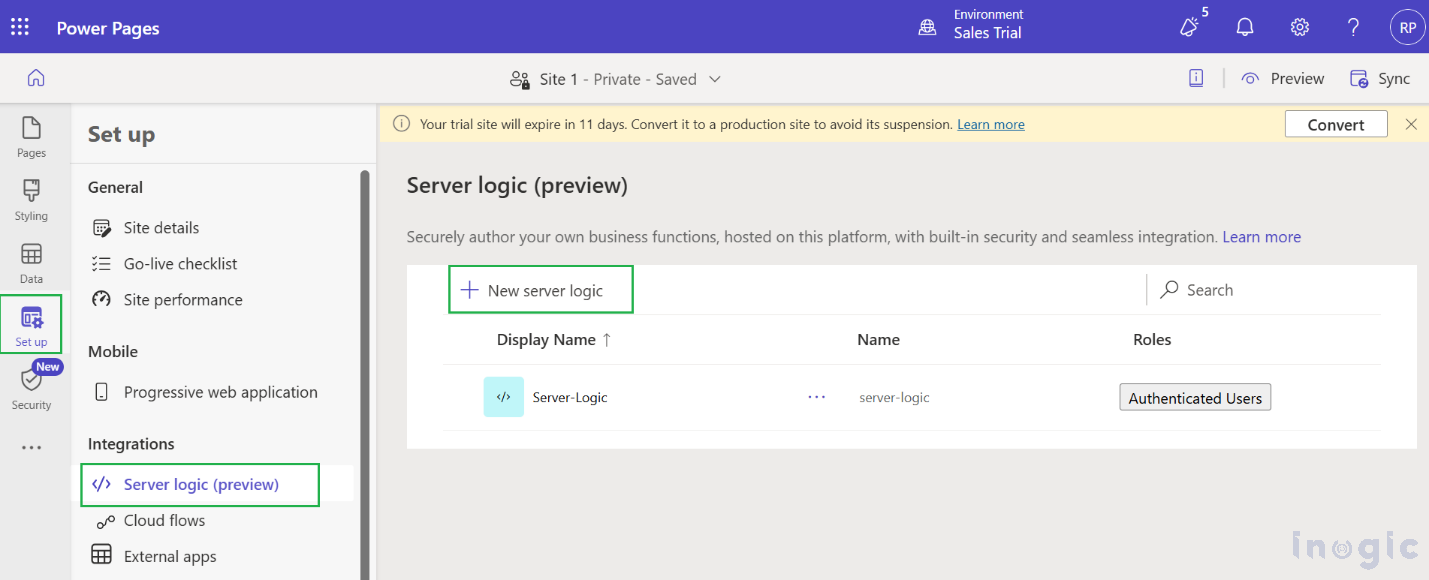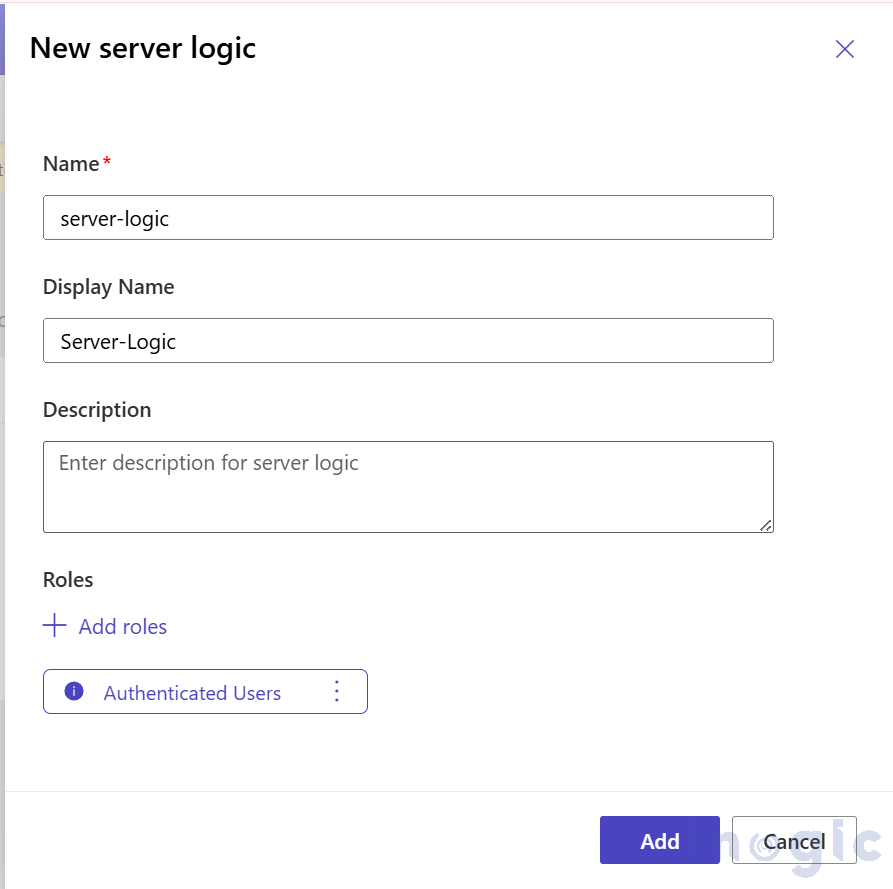Now Reading: How to Accelerate Power Pages Development Using Server Logic?
-
01
How to Accelerate Power Pages Development Using Server Logic?
How to Accelerate Power Pages Development Using Server Logic?

When developing portals or websites using Power Pages, makers often rely on client-side scripting or external flows to implement business rules, integrations, and data operations. While this approach works, it can sometimes introduce challenges around security, maintenance, and consistency.
The introduction of Server Logic in Power Pages helps overcome these limitations by moving your business logic to the server side, ensuring better security, centralized management, and easier maintenance across environments.
What is Server Logic?
Server Logic is a new Power Pages feature that enables you to author native JavaScript, which is executed securely in a managed environment rather than in browser.
This ensures:
- Sensitive code stays hidden
- Business logic is centrally managed
- Operations run faster and more reliably
Prerequisites:
Before you begin, ensure you have:
- An active Microsoft Dataverse environment.
- A valid Power Pages license and access to a Power Pages site.
How to get started
1. Open Power Pages and select your desired environment and site.
2. Navigate to Setup → Server logic (Preview).

3. Click + New Server logic to create a new logic component.

Provide the following details:
-
- Name: Internal name of the logic.
- Display Name: How it appears in the portal configuration.
- Description: Brief summary of what the logic does.
- Roles: Define which web roles can access this logic.
Note: Server Logic assigned to a higher web role won’t be accessible to lower roles.
Authoring Server Logic:
Once created, select your Server Logic and click Edit in Visual Studio Code to open and modify the script.
By default, you’ll see predefined functions such as:
get() { }
post() { }
put() { }
patch() { }
del() { }
Each function corresponds to standard HTTP methods and can be customized to perform logic such as querying Dataverse, validating input, or integrating with external APIs.
Calling Your Server Logic:
To execute your server-side logic, use the following endpoint:
https://<your-site-url>/_api/serverlogics/<server-name>
You can also pass query parameters to filter or identify records:
https://<your-site-url>/_api/serverlogics/<server-logic-name>?id=<record-id>
Inside your code, you can access these parameters like so:
let recordId = Server.Context.QueryParameters[“id”];
From here, you can write logic to retrieve or process data securely within the server context.
For example, you can write a simple GET operation that retrieves data based on a query parameter.
webapi.safeAjax({
type: ‘GET’,
url: “/_api/serverlogics/serverlogic?id= + id,
contentType: ‘application/json’
}).done(response => {
try {
// Write your Logic here
} catch (error) { // Error }
});
Key Facts:
- Code executes hidden from the browser, so end users cannot view or tamper with it.
- Logic is stored in Dataverse and follows the same deployment and lifecycle processes as other portal components.
What You Can Do with Server Logic:
Server Logic unlocks a range of capabilities that were previously difficult, insecure, or required workarounds:
- Securely integrate with external services: Connect with REST APIs, Azure Functions, or other external systems while keeping credentials and keys safe on the server side.
- Execute Dataverse operations with governance: Perform create, update, delete, or query actions securely without exposing logic in the browser.
- Pre-process or enrich data: Apply business rules, transformations, or validations before sending data to the client.
- Return optimized data to the client: Perform heavy operations server-side and return only what’s necessary, improving overall performance.
Key Benefits:
- Enhanced Security
Sensitive logic, validations, and API integrations are executed on the server, reducing exposure and minimizing risk. - Improved Performance & Scalability
Heavy computations and data operations happen on the server, resulting in faster, more responsive client experiences. - Consistency Across Channels
Server Logic ensures business rules stay consistent — whether users access data through forms, APIs, or embedded components. - Simplified Maintenance
Centralized logic reduces duplication, making updates and maintenance much easier across pages and environments. - Important Consideration:
- By default, the Maximum execution time is 120 seconds. Which can be increased up to 240 seconds.
- Maximum memory per function is 10 mb.
FAQs
1. What problem does Server Logic solve in Power Pages?
Server Logic removes the need for client-side scripts or external flows for sensitive or complex logic, making development more secure, consistent, and easier to maintain.
2. Where does Server Logic run?
It runs on the server side in a secure, managed environment and not in the browser, keeping your logic hidden from end users.
3. What kind of operations can I perform with Server Logic?
You can execute Dataverse operations, integrate with external APIs, validate inputs, process data, and run complex business rules.
4. How do I access Server Logic from my site?
You can call it using the endpoint:
/_api/serverlogics/<logic-name>
with optional query parameters.
5. Why is Server Logic more secure than client-side scripting?
All logic executes on the server, preventing users from viewing or tampering with your code.
6. Does Server Logic support role-based permissions?
Yes. You can define which web roles can access each Server Logic component.
7. What are the limitations I should be aware of?
- Execution time: 120s (extendable to 240s)
- Max memory: 10 MB per function
8. How does Server Logic improve performance?
By handling heavy operations server-side, it sends only optimized data to the client by resulting in faster, more responsive pages.
Conclusion:
The new Server Logic capability in Power Pages marks a major step toward making portals more secure, scalable, and maintainable.
By centralizing complex logic on the server, makers can focus on building reliable experiences without worrying about exposing sensitive code or managing redundant scripts across multiple pages.
The post How to Accelerate Power Pages Development Using Server Logic? first appeared on Microsoft Dynamics 365 CRM Tips and Tricks.
Original Post https://www.inogic.com/blog/2025/11/how-to-accelerate-power-pages-development-using-server-logic/















